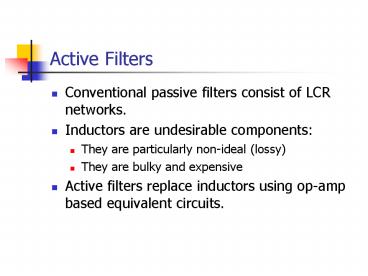Active Filters - PowerPoint PPT Presentation
1 / 18
Title: Active Filters
1
Active Filters
- Conventional passive filters consist of LCR
networks. - Inductors are undesirable components
- They are particularly non-ideal (lossy)
- They are bulky and expensive
- Active filters replace inductors using op-amp
based equivalent circuits.
2
Active Filter Designs
- Three active filter design techniques will be
covered - Synthesis by Sections
- Cascade of second order sections.
- Component Simulation
- Replace inductors with op-amp inductor
simulations. - Operational Simulation
- Simulate all currents and voltages in the LCR
ladder using an analogue computer.
3
Analogue Filter Responses
H(f)
H(f)
0
0
f
f
fc
fc
Ideal brick wall filter
Practical filter
4
Standard Transfer Functions
- Butterworth
- Flat Pass-band.
- 20n dB per decade roll-off.
- Chebyshev
- Pass-band ripple.
- Sharper cut-off than Butterworth.
- Elliptic
- Pass-band and stop-band ripple.
- Even sharper cut-off.
- Bessel
- Linear phase response i.e. no signal distortion
in pass-band.
5
(No Transcript)
6
Analogue Transfer Functions
The transfer function of any analogue filter
(active or passive) can be expressed as the ratio
of two polynomials
7
Poles and Zeros
- Poles
- Complex values of s where the transfer function
is infinite. - i.e. the denominator of the transfer function is
zero. - Zeros
- Complex values of s where the transfer function
is zero. - An N-th order filter will have N poles and up to
N zeros. - Some poles may be in the same place (as may some
zeros).
8
Example Two Pole Bessel Filter
Low pass, cut-off frequency 1 rad/s, from
tables
9
Operational Amplifiers
- All the active filters we shall study are based
on operational amplifiers (op-amps). - Analysis of linear op-amp circuits is usually
based on simplifying assumptions - The difference between the non-inverting and
inverting inputs is zero. - The input current is zero.
- The output voltage and current is arbitrary.
10
Op-Amp Assumptions
I
V
Iout
Vout
I-
-
V-
11
Inverting Amplifier
Z2
Z1
VIN
-
VOUT
0 V
12
Non-Inverting Amplifier
VIN
VOUT
-
Z1
Z2
0 V
13
Buffer Amplifier
VIN
VOUT
-
- Output voltage Input voltage
- Input impedance is infinite
- Output impedance is zero
14
Single-Pole Passive Filter
R
C
vin
vout
- First order low pass filter
- Cut-off frequency 1/CR rad/s
- Problem Any load (or source) impedance will
change frequency response.
15
Single-Pole Active Filter
R
C
vin
vout
- Same frequency response as passive filter.
- Buffer amplifier does not load RC network.
- Output impedance is now zero.
16
Low-Pass and High-Pass Designs
High Pass
Low Pass
17
Higher Order Filters
- You might think we could make higher order
filters by simply cascading N first order filters - This doesnt work
- The single pole of a first order filter must be
purely real (no imaginary part) - The poles of a higher order filter usually need
to be complex - Solution Use second order sections, each one
synthesising a conjugate pair of complex poles
18
Summary
- Active filter designs aim to replace the
inductors in passive filters. - Design techniques
- Synthesis by sections
- Component simulation
- Operational simulation
- All based on op-amps understanding of basic
op-amp circuits is essential.

